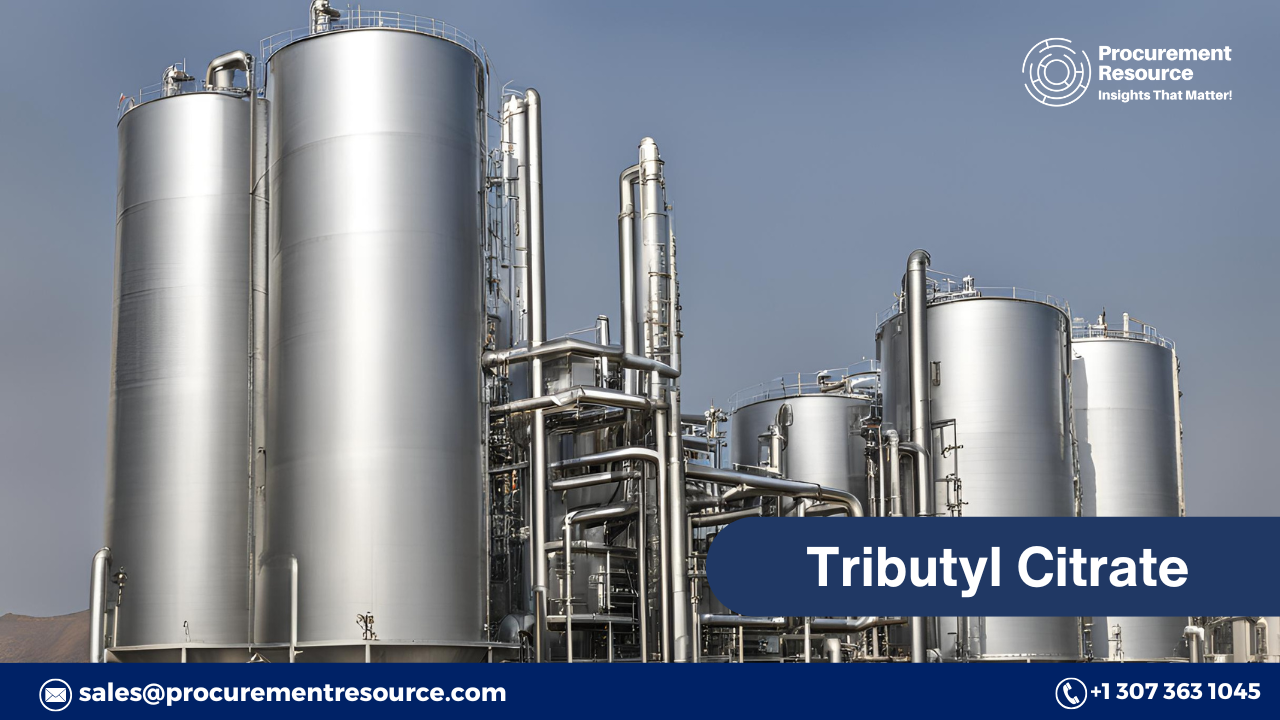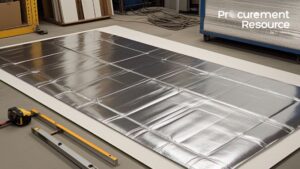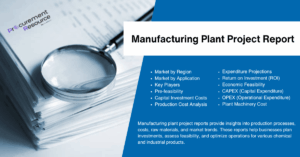Extensive Tributyl Citrate Production Process: Cost Model, Pre-feasibility, Industrial Trends, Labor Charges, Utilities, Logistics, Supply Chain, Lifecycle Cost Analysis, Global and Regional Outlook

Tributyl Citrate Production Process
In today’s competitive industrial landscape, understanding the production costs of key chemicals is essential for businesses striving for sustainability and profitability. Tributyl Citrate (TBC), a non-toxic and biodegradable plasticizer, has seen significant demand across various industries, including plastics, pharmaceuticals, cosmetics, and food packaging. As companies increasingly seek alternatives to harmful chemicals like phthalates, tributyl citrate stands out for its safer profile and eco-friendly properties. For manufacturers, knowing the detailed factors influencing TBC production costs is crucial for remaining competitive in the market. At Procurement Resource, we are committed to offering businesses the insights they need to make well-informed decisions about production processes and cost management. This article aims to provide a thorough overview of Tributyl Citrate Production Process, examining the critical drivers behind cost fluctuations, key industry trends, and how manufacturers can optimise production to stay ahead in this growing sector.
What is Tributyl Citrate (TBC)?
Tributyl Citrate (TBC) is an ester derived from citric acid and butanol. It is primarily used as a plasticizer and solvent, with its most common application being in the production of flexible polyvinyl chloride (PVC) plastics. TBC is preferred as a safer alternative to phthalates—a group of chemicals often associated with health risks like reproductive toxicity and endocrine disruption. Because of its non-toxic, biodegradable nature, tributyl citrate is widely used in consumer products that require close human contact, such as medical devices, food packaging, and cosmetics. The versatility of TBC makes it suitable for numerous industries, with applications in:- PVC manufacturing: TBC enhances the flexibility and workability of PVC products used in electrical cables, flooring, and medical tubes.
- Cosmetics: TBC is used in personal care products like lotions, shampoos, and perfumes as a stabilizer and solvent.
- Pharmaceuticals: TBC is involved in the formulation of sustained-release drugs, ensuring stable drug delivery over extended periods.
- Food packaging: As a safer, non-toxic plasticizer, TBC is increasingly used in packaging materials for food products.
Request a Free Sample For Tributyl Citrate Production Cost Reports — https://www.procurementresource.com/production-cost-report-store/tributy-citrate/request-sample
Factors Influencing Tributyl Citrate Production Costs
The cost of producing tributyl citrate is shaped by several key factors that affect the pricing of raw materials, energy, labor, and technology. Below, we explore these factors in detail:1. Raw Material Costs
The primary raw materials required to produce tributyl citrate are citric acid and butanol. The cost of these materials has a direct impact on the overall production cost of TBC.- Citric Acid: Produced through fermentation from sugar or molasses, citric acid is a key input for the production of TBC. Its price can fluctuate based on agricultural conditions, supply-demand dynamics, and the production capacity of major citric acid manufacturers. The demand for citric acid in the food and beverage industry, pharmaceuticals, and cleaning products can further influence pricing.
- Butanol: Butanol, a petrochemical derivative, is used to react with citric acid in the esterification process. Since butanol is primarily produced from crude oil, its price is closely tied to the volatility of global oil markets. Factors such as geopolitical events, crude oil production rates, and shifts in demand from other sectors (such as automotive or paints) can significantly affect butanol prices.
2. Energy Costs
Energy is a significant component of the overall operational cost in the production of tributyl citrate. The esterification reaction, where citric acid and butanol are chemically reacted in the presence of an acid catalyst, requires heat and, in some cases, pressure. The energy demand for this process is high, and fluctuations in energy prices—whether from natural gas, electricity, or steam—can substantially increase production costs. Regions with higher energy costs or unstable energy supply chains may experience higher production costs. As energy prices continue to rise globally, companies must invest in energy-efficient technologies to minimise the impact on production costs. Additionally, some companies are exploring renewable energy sources to mitigate the risk of fluctuating energy prices and reduce their environmental impact.Read Full Report — https://www.procurementresource.com/production-cost-report-store/tributy-citrate
procurementresource.com/production-cost-report-store/tributy-citrate/ask-an-analyst
procurementresource.com/production-cost-report-store/tributy-citrate/request-sample
3. Labor and Operational Costs
Labor costs are another important contributor to TBC production expenses. Skilled labor is necessary to manage the esterification process, ensure quality control, and maintain production systems. Labor costs vary depending on the region, with some countries having higher wage rates for skilled chemical engineers and operators. Operational costs include routine equipment maintenance, facility overheads, and the logistics of transporting raw materials and finished products. As production systems become more automated, some of these costs can be reduced. However, maintenance of equipment such as distillation columns, reactors, and filtration units is still required, and any unexpected downtime can add significant costs.4. Technological Advances and Process Optimization
Technology plays a crucial role in reducing the overall cost of tributyl citrate production. Advancements in chemical engineering, reaction optimization, and automation can lead to more efficient production methods, improved yields, and lower energy consumption.- Catalyst Efficiency: The development of more efficient catalysts can help reduce the energy needed for the esterification reaction, improving the yield and reducing waste. Efficient catalysts can also reduce the amount of raw material required, which in turn lowers production costs.
- Process Innovation: Improvements in reaction technology, such as continuous flow reactors or better distillation techniques, can result in higher throughput, lower energy consumption, and less material waste. These optimizations can significantly reduce the cost per unit of TBC produced.
- Automation: The integration of automation in the manufacturing process can reduce labor costs, improve consistency, and increase production efficiency. Automated systems also reduce the chances of human error, leading to fewer production losses.
5. Regulatory and Environmental Compliance Costs
With increasing regulatory scrutiny surrounding chemicals used in consumer-facing applications, compliance with environmental and safety standards is a significant consideration in the production of tributyl citrate. Companies must adhere to local and international regulations set by governing bodies such as the FDA, EPA, and European Chemicals Agency (ECHA).- Regulatory Testing: Tributyl citrate is often used in medical devices, food packaging, and cosmetics, which means it must meet stringent regulatory standards. Manufacturers may need to invest in additional testing, documentation, and certification to comply with safety and environmental regulations.
- Environmental Responsibility: Companies are increasingly adopting sustainable practices to meet consumer expectations and comply with environmental laws. Implementing cleaner production methods, reducing emissions, and managing waste properly can involve additional costs. However, these practices also create opportunities for differentiation and may attract environmentally conscious consumers.
Market Trends and Demand for Tributyl Citrate
As consumer awareness about the potential health risks of traditional plasticizers grows, tributyl citrate’s role as a safer, eco-friendly alternative is becoming more significant. Several trends are driving the demand for TBC:- Shift Away from Phthalates: Phthalates, which have been widely used as plasticizers in the past, are under scrutiny due to concerns about their toxicity and impact on human health. This has led to the growing adoption of non-toxic alternatives like tributyl citrate.
- Growth of the PVC Market: TBC is widely used in the production of flexible PVC, which has applications in sectors such as construction, healthcare, and automotive. As the demand for flexible PVC products grows, so does the need for efficient and safe plasticizers like TBC.
- Consumer Preference for Green Products: Consumers are increasingly demanding products made from environmentally friendly and safe materials. This is pushing manufacturers to adopt non-toxic plasticizers and solvents like tributyl citrate in their formulations.
Strategies for Managing Tributyl Citrate Production Costs
Given the multiple factors influencing production costs, manufacturers must develop cost-effective strategies to optimise production and improve profitability:- Raw Material Procurement: Long-term contracts with suppliers of citric acid and butanol can help mitigate the risk of price fluctuations. Diversifying suppliers or sourcing materials from more cost-effective regions can also reduce material costs.
- Energy Efficiency: Investing in energy-efficient technologies, such as heat recovery systems or more efficient reactors, can help lower energy consumption. Additionally, transitioning to renewable energy sources, such as solar or wind power, can offer long-term cost benefits.
- Process Optimization: Continuously evaluating and improving the production process through technological upgrades, better catalysts, and automation can lead to significant cost savings. Implementing process controls to reduce waste and improve yields can have a direct impact on the unit cost of TBC.
- Regulatory Compliance: Investing in meeting regulatory standards upfront can prevent costly fines and penalties down the line. Moreover, adopting sustainable production practices can enhance a company’s reputation, appealing to eco-conscious consumers and expanding market opportunities.
Tributyl citrate is a vital chemical used across a range of industries, particularly where safety and sustainability are paramount. Understanding the factors that influence the production costs of TBC, such as raw material prices, energy consumption, labor costs, and technological innovations, is essential for businesses seeking to remain competitive in this growing market. By adopting cost-effective strategies, leveraging technological advancements, and staying ahead of regulatory trends, manufacturers can optimise their production processes and achieve long-term profitability.
Contact Us:
Company Name: Procurement Resource
Contact Person: Leo Frank
Email: sales@procurementresource.com
Toll-Free Numbers:
- USA & Canada: +1 307 363 1045
- UK: +44 7537171117
- Asia-Pacific (APAC): +91 1203185500
Address: 30 North Gould Street, Sheridan, WY 82801, USA






